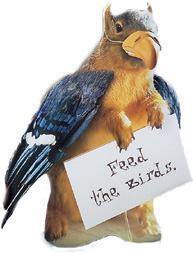-
Are Butterfly Houses for Aesthetics or Shelter?
Surprising to me, we had a wonderful butterfly season in the Atlanta area this year. I can’t recall a summer where so many had populated my yard. I know the two leaf misters were a huge attraction for them, along with some newly planted milkweed. Other flowers like lantana and abelia shrubs saw lots of action from these winged jewels too. There is no butterfly house in the yard, and I’ve always wondered whether or not butterflies really use them?
Some butterfly houses are like detailed works of art for the garden, they enhance and add a nice focal point to the area. The butterfly house shown here is constructed of durable red cedar, and the etched glass panels that catch light beautifully. It’s available as a hanging, or post mount model too.
But back to the question if butterflies really use butterfly houses or not?
A bit of research reveals the answer here: -
Recycled or Wooden Bat Houses?
The (not so new anymore) wave of recycled plastics is still a wonderful thing as for as birding accessories. Durable, tough, handsome, and most come with guarantees against splitting, cracking or fading. Bat houses are now available in recycled plastics, and like all other products, guarantee a longer life…in fact…a lifetime of use.
One of the advantages to this recycled bat house is the rich, dark color. Not only for aesthetic purposes, it retains heat from the sun to keep the chambers warmer on cold nights. It’s large enough to hold hundreds of the beneficial little brown bats, whole colonies if you will. Excellent for natural pest control, bats will consume whole populations of mosquitoes in one night.
Wooden bat houses are still mainstream, and are available for smaller groupings and large colonies too. Bat House Kits are even available if you’re so inclined to build your own. Most wood bat houses are constructed of red cedar, also durable and very long lasting. If purchasing a bat house, your decision may be based on looks, size, and or price. A wide variety of bat houses are available, the key is proper placement. Approximately 15-20 feet from the ground is best, usually facing a southern or southeast exposure. They may be post or pole mounted with additional hardware, or simply attached to a tree. Some say they can be erected on structures as well, we would not recommend this.
Help brown bats to thrive flourish in your yard by offering proper shelter and you’ll be rewarded with natural insect control for the season!
-
Foiled by the Squirrel Baffle
He’s arch enemy number one to most backyard birders! Raiding bird feeders relentlessly until empty, they continue even to destroy the feeder itself. Squirrels can be an impossible pain in the keester, no matter how you try to solve the problem.
To the rescue…a quality squirrel baffle placed in the correct position. When installed properly, squirrel baffles make it impossible for these furry critters to get
at feeders. Because of their amazing acrobatics, you must always remember it’s not just the height from the ground, but the horizontal distance from any jumping spot. They can leap tall buildings at a single bound, so feeders must be at least eight feet away from where squirrels can get a foot hold and jump across.
With the investment of a squirrel baffle (and they really aren’t even that expensive) you’ll save money by saving birdseed. You’ll also allow your feathered friends to dine in peace, thus seeing more of the activity you were hoping for.
If the squirrel baffle is a pole mounted one, be sure the bottom of the baffle is at least five feet from the ground. Squirrels will shimmy on up the pole, but will be foiled every time by the baffle. Knowing that you’ve finally won the battle, it’s a pretty entertaining site too!





